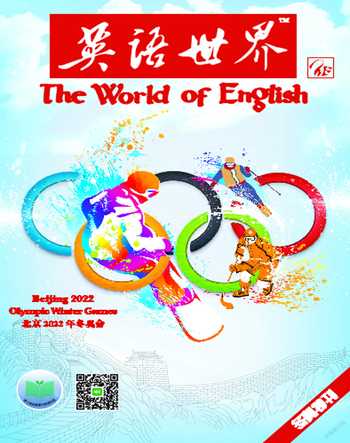Interesting Medals 奖牌趣事
凌岚
The Winter Olympic Games using the emblematic1 Olympic medals is a fascinating artistic and cultural experience. Their design must take into account certain visual elements defined by the IOC and the OCOG2, with the IOC having the final approval. They must show the Olympic emblem, the full name of the Games in question, the name of the sport or discipline concerned and the OCOG’s emblem. Additionally, the Winter Games medals should reflect the visual look, plus cultural and aesthetic elements selected by the OCOG.
Now let’s look at some representative and interesting Olympic medals:
The obverse depicts the emblem of the Olympic Winter Games Innsbruck 1976 comprising the Olympic rings and the coat of arms3 of the city showing the bridge on the Inn which gives the city of Innsbruck its name4. For centuries, this bridge has been the link between the old town and the Hötting district. It symbolizes friendship and the people of the world coming together. The inscription “XII OLYMPISCHE WINTERSPIELE INNSBRUCK 1976” surrounds the scene.
The reverse shows the Bergisel skiing area with the Alps in the background and the Olympic flame in the foreground on the right hand side.
Salt Lake City 2002
On the obverse, an athlete bursts from flames carrying a torch, representing the resilience of the human spirit and the power to inspire. The figure has triumphed over adversity and is thus released from a mountain of ice and rock. The Olympic Rings anchor5 the image of the athlete, while the theme of the Olympic Winter Games Salt Lake City 2002 “Light the Fire Within” is etched into the medal, marking the first time that an organizing committee’s vision statement is included on a medal.
On the reverse, Nike, the Greek goddess of victory, holds a small victory leaf6, symbolizing the olive wreaths that were presented to winners of the ancient Olympic Games. Within Nike’s embrace is an illustration of the event for which each medal is being presented. The emblem of the Olympic Winter Games Salt Lake City 2002 and the name of the event figure are illustrated on the reverse of each medal. At the base of the ribbon loop is the Roman numeral XIX, signifying the XIX Olympic Winter Games.
The medals are designed in the shape of river rocks, like those found in Utah’s streams and rivers. Part modern and part rustic, they embody the spirit of the American West from the forging of the West to the technological present. Each medal is hand-finished and is slightly different from the other medals similar to individual rocks sculpted by water and wind.
On the obverse, it presents the graphic elements of the Games.
On the reverse, the pictogram of the sports discipline in which the medal was won.
The medal is round like the Olympic rings or a symbolic victory ring and, with its open space at its centre, it reveals the place where the heart beats, the symbol of life itself. To highlight the three-dimensional characteristics of the medal, its surface has been carefully made using full and empty spaces, with shiny and satiny textures. The medal is only complete, however, when it is hanging geometrically from the athlete’s neck, lying on his/her chest, circling and revealing the area near his/her heart and focusing attention on the athlete’s vital energy and human emotions.
On the obverse, the Olympic rings.
On the reverse, the name of the event in English and the emblem of the Olympic Winter Games Sochi 2014.The Sochi 2014 mosaic “patchwork quilt” of national designs from the various culture and ethnicities of the Russian Federation is featured on the metal and polycarbonate parts of both sides of the medal.
On the rim, the inscription “XXII OLYMPIC WINTER GAMES” (also in French and Russian). The medals represent the landscape of Sochi with the snowy mountain tops reflecting the sun’s ray onto the sandy beaches of the Black Sea coast.
奧运奖牌是冬奥会的符号,奖牌的使用是冬奥会一场迷人的艺术和文化体验。奖牌设计必须考虑到国际奥委会和奥组委定义的某些视觉元素,并由国际奥委会最终批准设计方案。奖牌必须展示奥运会会徽、该届奥运会的全称、相关运动项目或小项目的名称和奥组委的会徽。此外,冬奥会奖牌应反映出奥组委选择的视觉外观、文化和美学元素。
现在我们来欣赏一些有代表性的、有趣的奥运奖牌:
正面是1976年因斯布鲁克冬季奥运会的标志,包括奥林匹克五环标志和因斯布鲁克市的盾形市徽,市徽图案是因河上的桥,这也正是城市名字的由来。几个世纪以来,这座桥一直是老城区和霍廷区之间的纽带。它象征着友谊和世界人民团结在一起。外圈围绕着“第12届冬季奥运会,因斯布鲁克,1976年”字样的铭文。
反面以阿尔卑斯山脉为背景,描绘了伯吉瑟尔滑雪区,并在右手边前景展示了奥运圣火。
奖牌正面图案中,一名高举火炬的运动员冲出烈焰重围,代表了人类精神的不屈和激励的力量。这名运动员战胜了困境,得以从重重冰岩的包围中脱身。运动员稳稳地站在脚下的奥运五环上,2002年盐湖城冬奥会的主题“点燃心中之火”也刻在了奖牌上,标志着史上第一次将组委会的愿景宣言包括在奖牌图案中。
奖牌背面,希腊神话中的胜利女神奈基手持一片月桂树叶,象征着颁发给古代奥运会胜利者的橄榄花环。奈基女神臂弯形成的环区中刻画着代表该运动项目的图案。2002年盐湖城冬奥会的会徽和项目的名称也出现在每块奖牌的背面。在丝带挂环的底部刻有罗马数字19,表示是第19届冬季奥运会。
奖牌设计成河里鹅卵石的形状,就像在犹他州小溪和河流中的石子。现代中带着原始,它们象征着从西部缔造之日开始到科技发达的今日,一直延续的美国西部精神。每块奖牌都由手工制作完成,与其他奖牌都略有不同,就像一块块水蚀风刻的石片。
奖牌正面是奥运会的图形元素。
奖牌反面是获奖项目的象形图案。
奖牌是圆形的,像奥林匹克五环或象征胜利的花环,中间的空洞正好露出佩戴者心脏跳动的位置,象征着生命本身。为了凸显奖牌的三维特征,奖牌表面精心利用了充实与空缺的空间,具有光泽和绸缎的质感。然而,只有当奖牌垂直挂在运动员的脖子上,贴在其胸前,圈出并突显出心脏附近的区域,才会让人注意到运动员的生命力与情感,奖牌才算完整。
奖牌正面是奥运五环。
奖牌背面刻有运动项目的英文名称和2014年索契冬奥会的会徽。代表俄罗斯联邦多元文化和不同种族的民族风设计——马赛克式“拼布被面”图案——出现在2014年索契冬奥会奖牌正反两面的金属和聚碳酸酯部分。
奖牌边缘用英语、法语和俄语铭刻着“第22届冬季奥运会”的字样。奖牌重现了索契的风景:积雪的山顶将阳光反射到黑海沿岸的沙滩上。
(英文选自国际奥委会网站www.olympic.org)

